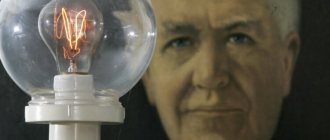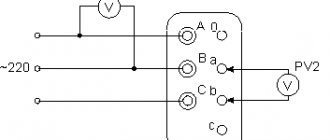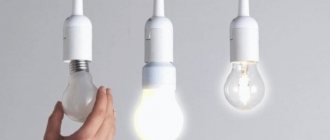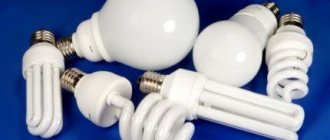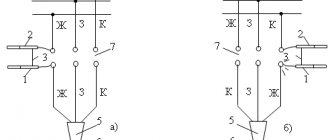We are all familiar with the electric light bulb. It gives the room a beautiful amber glow. The room immediately becomes warmer and more comfortable.
An incandescent lamp consists of a metal filament that glows brightly when heated (nowadays tungsten is most often used), a bulb filled with an inert gas or with an airless space and elements that conduct current to the filament.
Thomas Edison made a huge contribution to the development of electric lighting. The inventor carried out a lot of research work, in which he tried different conductors as an incandescent filament. He also invented the threaded plinth.
Edison's first light bulb looked almost exactly like modern incandescent light bulbs. The filament in it could have different shapes, the base had a diameter of 27 mm. The bulbs in the electric lamps of this inventor also looked different, but in one of the first lamps created by the inventor it was spherical.
Who invented the light bulb - Edison, Lodygin or Yablochkov?
One of the most common myths about the incandescent lamp is that Edison invented it. This is wrong. The first scientist who created an electric lamp that worked not only in the laboratory was Alexander Nikolaevich Lodygin. In 1872, after a series of experiments, he was the first to use a carbon filament in a vacuum. His lamps were first used to illuminate streets. Later (in 1890) he replaced the carbon in the filament with tungsten.
Pavel Nikolaevich Yablochkov also made a great contribution to the history of the development of electric lighting. In 1874, he created a lamp (later it was called the “Yablochkov candle”), which did not have a mechanism that prevented the electrodes from touching.
Thomas Edison was undoubtedly a great scientist. Thanks to him, electric lamps became very widespread, but he did not invent them, but only improved them. As a result of his research and improvements, the service life increased several times, the price decreased many times, which is why the lamps became available to almost everyone.
So who invented the first incandescent lamp in the world?
No one specific. How so? The fact is that in fact, the invention of the light bulb is a collective effort. A number of scientists conducted experiments with electricity, made mistakes, continued trying, proposed their own versions of the invention, received patents and presented inventions.
Other scientists were inspired by the work of their colleagues or made significant changes to the design, improving it more and more.
Formally, there are three “founders” of modern lamps - Lodygin, Edison and Yablochkov. Their inventions had fundamental schematic differences, but nevertheless they formed the basis of modern incandescent lamps that illuminated our streets, houses and shops.
Subscribe to our Social networks
Edison or Swan?
The light bulb was first demonstrated by Edison on December 31, 1879. For this he prepared a grand show. Several specially ordered trains arrived in Menlo Park, a small city in California. They were attended by journalists, officials and all those who were interested in science and new inventions. A truly magical picture appeared before their eyes - the streets of the town were illuminated with electricity, in the windows of houses and workshops one could see the light produced by a new miracle of technology. It was the first research center prepared for the development of new technologies.
Later, scientists conducted several more demonstrations, one of the largest at a scientific exhibition in Paris in 1881. It was after this exhibition that the demand for incandescent lamps increased significantly.
But not everyone was happy about the appearance of lighting on city streets. The German newspaper Kölnische Zeitung published an article arguing against street lighting. According to newspapermen, it scared horses, helped criminals and contributed to the “decline of morals.”
Edison patented the platinum filament incandescent lamp in the fall of 1879. And in 1880, he created a base, a switch and improved a lamp with a carbon filament of fusion.
Edison was also not its inventor. It was first invented by Joseph Swan in 1850, and he patented and demonstrated his invention in 1860. However, there had to be a vacuum in the bulb of his light bulb, and due to the difficulties of obtaining it, Swan's development was suspended. A little later, he returned to his developments, received a new patent in 1878 and demonstrated his invention in February 1879.
But Thomas Edison was the first to put incandescent lamps into mass production - this helped them become widespread. He also achieved an increase in service life several times.
Incandescent lamp: prototypes
The invention of the incandescent light bulb is credited to several scientists. Some of them worked at the same time, but in different countries. Scientists who worked at a later time made significant improvements to the inventions of their predecessors. Thus, creating an incandescent lamp is the work of several people.
Direct development of designs with incandescent elements began in the 30s of the 19th century. The Belgian scientist Jobard introduced the world to the first carbon-core design. His coal lamp was not widely used only because it burned for no more than 30 minutes. However, this was progress at the time.
At the same time, the English physicist Warren de la Rue presented his lamp with a platinum element in the form of a spiral. The platinum shone brightly, and the vacuum inside the glass bulb made it possible to use it in any weather conditions. Warren de la Rue's invention became the prototype for other designs, although it itself did not receive further development due to its high cost.
Another English physicist, Frederic de Moleyn, slightly changed de la Rue’s brainchild, installing platinum threads instead of a spiral. However, they quickly burned out. A little later, physicists King and John Starr improved the design of their English colleagues. The Englishman King replaced platinum threads with carbon sticks, increasing the duration of their combustion. And the American John Starr came up with a design with a carbon burner and a vacuum sphere.
History of Edison's lamp
Thomas Edison sold newspapers from a young age. At the age of 15, he came up with a way to advertise newspapers by announcing their announcements by telegraph. With the profits he made, he opened his own printing house. Later he moved to the small town of Menlo Park and continued to invent various devices there. The inventor improved the telegraph machine and carbon microphone, and invented the telephone microphone and phonograph.
Edison's work on improving lighting began when William Walas gave him a dynamo (direct current generator) and a set of arc lamps in 1878. In April 1879, the inventor realized that without a vacuum or inert gas, the operation of the lamp was impossible. And in October of the same year, he completed work on a lamp with a carbon filament. One of Edison's main ideas was to reduce the price of electricity and incandescent lamps. He wanted light bulbs to become so cheap that only rich people would burn candles. And he succeeded. In the first year of production, the company sold light bulbs below their cost - they cost $1.10 apiece, the company sold them for 40 cents, but that year the company produced only 20 or 30 thousand copies. The following year the price dropped to 70 cents, but the business still sold at 40 cents each. That year, many more light bulbs were produced than the first, and the company lost a large amount of money. But in the 4th year of sales of electric lamps by Edison's company, the cost dropped to 37 cents, and he returned all the money spent. In the following years, due to the automation of factories, the cost of light bulbs dropped to 22 cents, but they continued to be sold for 40 cents.
In 1892, Edison's company merged with a larger electrical appliance company, General Electric. Lodygin later sold the patent for an electric lamp with a tungsten filament to the same company.
Interesting Facts
- Edison is credited with inventing the simplest tattoo machine. The reason was five points on Thomas's left forearm, and then the Stencil-Pens engraving device, which was patented in 1876. However, the father of the tattoo machine is considered to be Samuel O'Reilly.
- The inventor is responsible for the death of the elephant Topsy. Three people died due to the animal's fault, so they decided to kill it. In the hope of winning the “war of currents,” Edison proposed executing the elephant with an alternating current of 6000 volts, and recorded the “performance” on film.
Execution of Topsy the Elephant
- The biography of the American genius includes a failed project, for the implementation of which they even built an entire plant to extract iron from low-grade ore. Compatriots laughed at the inventor, arguing that it was easier and cheaper to invest money in ore deposits. And they turned out to be right.
- In 1911, Edison built an uninhabitable house consisting of concrete, including window sills and electrical pipes. At the same time, the man tried himself as a furniture designer, presenting concrete interior items to future buyers. And again he failed.
Thomas Edison Magnetic Iron Ore Separator
- One of the wild ideas was the creation of a helicopter powered by gunpowder.
- The invention of the long-life lamp did humanity a disservice - people's sleep was reduced by 2 hours. By the way, when improving the light bulb, calculations took 40,000 pages of notebooks.
- The word “hello”, which starts a telephone conversation, is also Edison’s idea.
"Russian Light". Lodygin and Yablochkov. To the 170th anniversary of the inventors
11/26/2017 Bell Elena Grigoryan
For the glory of the Fatherland
Today, you and I, friends, are not at all surprised by such an object as a light bulb. And everyone knows how to handle it: if it burns out, they screw in a new one. But just one hundred and forty years ago, a glass luminous ball was considered a real miracle! Imagine the picture: St. Petersburg, carriages with elegant ladies and gentlemen gather at a house on Konnogvardeyskaya Street, where a show of Alexander Lodygin’s newest invention is being held. And here he is: black-haired, in a tailcoat, he begins to light up glass prisms, pears, balls - like a magician! He explains: this lamp is suitable for the railway, this one is suitable for indoors... The audience is shocked by what they see and applauds
Everyone understands: something very important for all humanity is happening before their eyes.
Alexander Nikolaevich Lodygin (photo from samsud.ru)
For many millennia, only living fire helped people disperse the darkness, and only in recent centuries oil and gas lamps, and kerosene lamps replaced splinters, torches and candles. But then came the age of electricity. Throughout the 19th century, in many places around the world, scientists tried to create an electric lamp, but all the samples did not work for long and were unreliable. And the first to eliminate most of their shortcomings was our compatriot Alexander Nikolaevich Lodygin. He came up with the idea of heating various metals inside a glass ball, passing an electric current through them, and in the end he got an almost modern light bulb, familiar to all of us.
Lodygin incandescent lamp (photo from polymus.ru)
It would seem that the invention will be immediately put into production in order to illuminate the whole of Russia over time. But, sadly, where the most important decisions for the country were made, they treated him with indifference - it was too difficult for domestic technical innovations to take root on their native soil, unlike foreign ones. And in Europe, which willingly encouraged technical innovations, in 1874 the Russian engineer Lodygin was granted a patent for the invention of an incandescent lamp. And when the American Edison and the Englishman Swan sued each other, proving which of them was the first to invent the light bulb, their dispute was stopped by a court decision: “Lodygin was the first.” However, Alexander Lodygin himself was completely uninterested in all this - the main thing for him was the embodiment of ideas in his homeland. Even in the most difficult conditions. “I work from dawn to dusk. But I have neither money nor experience. A bench vice and a hand pump are my only helpers...” he wrote to his loved ones bitterly.
Fortunately, he was not alone in his quest. In the same years, another of his compatriots, Pavel Yablochkov, worked on the creation of an electric lamp.
Pavel Nikolaevich Yablochkov (photo from peterpokrovsky.ru)
In his own way, he came to a light bulb of a slightly different design. But then everything repeated itself: in Russia they were not interested in his invention, but in Europe “Yablochkov’s candle” was enthusiastically received, the headlines of all the newspapers screamed about the “Russian light” that flooded the dark streets of European cities...
Yablochkov arc lamp (photo from mnogoznanie.ru)
If Pavel Nikolaevich had stayed in France, he would have lived comfortably in fame and wealth. Instead, he commits a “crazy” act: he buys for a million francs the enterprise producing the lamps he created and with this capital returns to his homeland, and he spent his entire fortune on the purchase. In Russia, things did not go as well as abroad, but Yablochkov did not lose heart. He set up production and began publishing an educational magazine on electrical engineering. And Lodygin, who turned out to be completely restless, invited him to work for him - someone will be surprised. But they were both bad businessmen and didn't think about such things. They were comrades. Even their fates are almost mirror-like. Both were born in the fall of 1847 into noble, well-born, but impoverished families, both received a military education, as was customary in their families, but had no attraction to army service and parted with it with a light heart, plunging headlong into electrical engineering. And most importantly, they were both ardent patriots. Working in a foreign land was painful for them, and at the first opportunity both hurried to their homeland. Even though they knew how unmerciful she would be towards them.
← Previous publication Next publication → Contents of the issue
Starting a successful career
CITY LIGHTS
In 1869, Edison came to New York with the desire to find a permanent job. Luck smiled on Thomas, setting up a fateful meeting: in one of the companies he found the owner repairing a machine for sending reports on the exchange rate of gold and securities. Edison quickly repairs the device himself and gets a job as a telegraph operator. By using the ticker, Thomas improves the design of the device, and the entire office where he works switches to his updated machines.
UNSEEN CAPITAL
Most people believe that one day they will wake up rich.
They're half right. Someday they will really wake up.
In 1870, Mr. Lefferts, head of the Gold and Stock Telegraph Company, offered to buy out Edison's development. He hesitated how much to ask: 3 thousand dollars? Or maybe 5? Edison admits that the first time he almost fainted was at the moment when the head of the company wrote him a check for $40,000.
Edison received the money through adventure. At the bank, the cashier returned the check to him for signature, but Thomas did not hear it and thought that the check was bad. Edison returned to Lefferts, who sent an employee to the bank to accompany the deaf inventor. The check was cashed in small bills, and Edison was afraid of a police patrol on the way home: what if he was confused with a robber? The inventor did not sleep at night, guarding the fallen treasure. He calmed down only after getting rid of a large amount of cash by opening a bank account the next day.
FIRST WORKSHOPS
In the city of Newark, New Jersey, a young man opens a workshop where he produces ticker devices. He enters into contracts with telegraph companies for the supply and repair of devices, and hires over a hundred workers.
In letters home, 23-year-old Edison said: “I have now become what you Democrats call a “bloated Eastern entrepreneur.”
Smiling Edison and Henry Ford as Sheriff
Advantages and disadvantages.
| Advantages | Flaws | |
| 1 | Contains no mercury | High power consumption |
| 2 | High color rendering index - no color distortion | Price |
| 3 | Simplicity of design: standard cartridge, no additional transformers | Fragility of the flask |
| 4 | Varied design | Strong surface heating |
| 5 | It is possible to regulate the glow power | |
| 6 | Possibility of creating an original interior |
Operating rules.
Do not forget the safety rules when using lamps:
- For connection it is necessary to use only certified cartridges.
- Light sources should only be inserted and turned out when they are cold: you won’t burn your hands and the light will shine longer.
- The life of light bulbs can be extended by reducing the number of on-off cycles.
- When using a dump in a portable lamp, move it from place to place only when it is turned off.
Thus, vintage Edison lamps came back into fashion. They have many advantages: ease of connection, soft, pleasant light, interesting design. Lamps will help create a cozy and stylish interior. Don't be afraid to experiment!
- Related Posts
- Relevance of LED lighting in 2022: efficiency, pros and cons
- The first light bulb
- Phosphor: composition, purpose and application
Manufacturers and models.
Among the most famous countries producing retro lamps are Switzerland (Richi Light AG), Holland (Calex), Denmark ( Danlamp) and China (Uniel).
- The Swiss brand Richi Light AG has been on the market since 1906. Their products are of high quality, the service life of the products is above nominal. The most critical light bulb components are assembled by hand.
| An example of the Swiss company Richi Light AG | ||
| Standart Deluxe Super is a classic pear-shaped light bulb with an E27 socket. Power 60 W. Length 105 mm, diameter 60 mm. | P64 Deluxe with expanding bulb and E27 base. Power 60 W. Length 135mm, diameter 64mm. | ROHRE DELUXE – cylindrical lamp with E14 base. Power 40 W. Length 114 mm, diameter 20 mm. |
- The Dutch company Calex produces designer lamps.
| Example of the Dutch company Calex | ||
| Goldline G-60 is a spherical light bulb with an E14 base. Power 25 W. Length 100 mm, diameter 35 mm. | Goldline-Filamentlamp442430 Clear in the shape of a fir cone . Base E14. Power 25 W. Length 80 mm, diameter 60 mm. | Goldline T45 is a cylindrical lamp with an E14 socket. Power 25 W. Length 114 mm, diameter 20 mm. |
- Danish Danlamp has been producing products since 1931. In collaboration with designers, he makes beautiful and high-quality light bulbs.
| An example of the Danish company Danlamp | ||
| DANLAMP MEGA EDISON 60 W E27 – pear-shaped light bulb. Length 170 mm, diameter 125 mm. | DANLAMP MINI EDISON 25 W E27 flared shape. Length 90 mm, diameter 45 mm. | DANLAMP Tube lamps 25W E14 – cylindrical lamp. Length 115 mm, diameter 20 mm. |
- The Chinese brand Uniel produces aesthetic, reliable and inexpensive lamp models.
| An example of the Chinese company Uniel | ||
| IL-V-G80-60/GOLDEN/E27 – pear-shaped light bulb. Power 60 W. Length 120 mm, diameter 80 mm. | IL-V-ST64-60/GOLDEN/E27 – lamp of an expanding shape. Power 60 W. Length 144 mm, diameter 64 mm. | IL-V-L28A-60/GOLDEN/E27 – cylindrical light bulb. Power 60 W. Length 185 mm, diameter 28 mm. |
In addition to the listed companies, there are manufacturers from Germany (Voltega), Spain (Loft IT), Poland (Nowodvorski) and other countries.
Finding the perfect light bulb
A century and a half ago, dim gas lighting was replaced by electric lighting. As often happens with scientific breakthroughs, the idea was literally in the air when three inventors took up its implementation almost simultaneously: Pavel Yablochkov, Alexander Lodygin and Thomas Edison. By a beautiful coincidence, they were all born in the same year - 1847.
Lodygin experimented with already known incandescent lamps, trying to extend their service life due to the new filament material. In 1874, he received a patent for his lamp with a luminous carbon rod inside a transparent vessel without access to oxygen.
Pavel Yablochkov was inspired by Lodygin’s experiments in lighting streets and premises in Russia: the successful example of his peer forced Pavel Nikolaevich to focus on electric lamps. In 1874, he took part in lighting on the railway: for the first time in history, a searchlight with an arc lamp - a Foucault regulator - was installed on a steam locomotive. It was a government train from Moscow to Crimea. Yablochkov had to constantly change the coals in the device and tighten the regulator, and then drag complex equipment from one locomotive to another - and so on all the way. After this trip, the young engineer decided that a new method of electric lighting was needed - without the Foucault regulator, which was very complex and required constant attention.
Pavel Yablochkov, Alexander Lodygin and Thomas Edison
Numerous and persistent experiments in electrolysis, which Pavel Nikolaevich conducted in 1875, led to the creation of Yablochkov’s candle. In one experiment, coals placed parallel in an electrolytic bath accidentally touched each other and flashed for a moment, lighting up the laboratory. Yablochkov decided that the future lay with the electric carbon arc lamp, and began to work closely on the device. Much time was spent selecting the insulating substance and obtaining suitable coals. What was the Yablochkov candle? A very simple and cheap device: two rods, separated by an insulating kaolin spacer, were clamped separately into the candlestick terminal. An arc discharge occurred at the upper ends, causing the arc flame to flare brightly and burn until the coals were burned.
By the way, the first electric arc was experimentally obtained and described by another Russian scientist - physicist Vasily Petrov. As early as 1802, he detected flames when he passed current through two charcoal rods. More than 70 years passed before this discovery resulted in a working device and a patent. March 23, 1876 became a milestone in the history of the development of lighting technology and the triumph of the Russian inventor.
They started talking about him in France, Britain, and the USA. The world press did not spare epithets, which are still pleasant to read today: “Russia is the birthplace of electricity”, “Light comes to us from the north - from Russia”, “Northern light, Russian light - a miracle of our time” “You should see Yablochkov’s candle”, “The invention of the Russian retired military engineer Yablochkov is a new era in technology.”
Yablochkov's candle had advantages over Lodygin's coal lamp. It turned out to be simpler and cheaper: the first samples sold for 20 kopecks. and served for an hour and a half, after which it was necessary to insert a new candle into the lantern. Over time, know-how appeared: lanterns with automatic replacement of candles.
Death
For the last decade of his life, the scientist was interested in the afterlife. The 73-year-old inventor, in an interview with Forbes, notified readers that he was constructing a device for communicating with the dead - a necrophone. William Dinudi, Edison’s colleague, entered into an “electric pact” with him: the first person to die promised to send the survivor a message “from the other world.” Dinudi died first, in 1920. Probably, Edison's attempt to establish communication with the other world was not successful, judging by the lack of industrial production of necrophones.
Edison was not sure whether there was an existence after death, but one day he admitted to his wife: “I lived my life and did the best I could.” The scientist died on October 18, 1931 at the age of 84 from complications of diabetes mellitus. Mina's wife survived her husband by 16 years. The inventor's grave is located in the backyard of his estate.
Graves of Thomas Edison and his wife Mina Miller
In Dearborn, the Henry Ford Museum displays a glass flask with the sealed “last breath” of a genius - the air from Edison’s room was sealed into a beaker by his attending physician.
In September 2022, the trailer for the film “The Current War” was released, where the role of Thomas Edison is played by Benedict Cumberbatch.
Benedict Cumberbatch as Thomas Edison
Thomas Edison is one of the greatest minds of his era, the most successful inventor of the 19th century.
If we did everything in our power, we would surprise ourselves
These words belong to a man who knew how to implement ideas and bring what he started to completion.
List of sources used
- Mikhail Lapirov-Skoblo. Edison.
- Kamensky Andrey. Thomas Edison. His life and scientific and practical activities.
- Thomas Edison National Park website https://www.nps.gov/edis/index.htm
- Nadezhdin N. Ya. Informal biographies. Thomas Edison: The Inventive Man.

